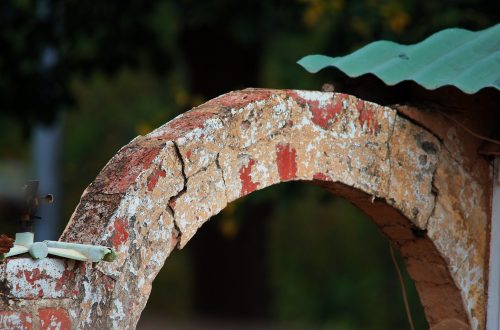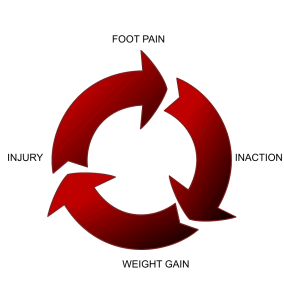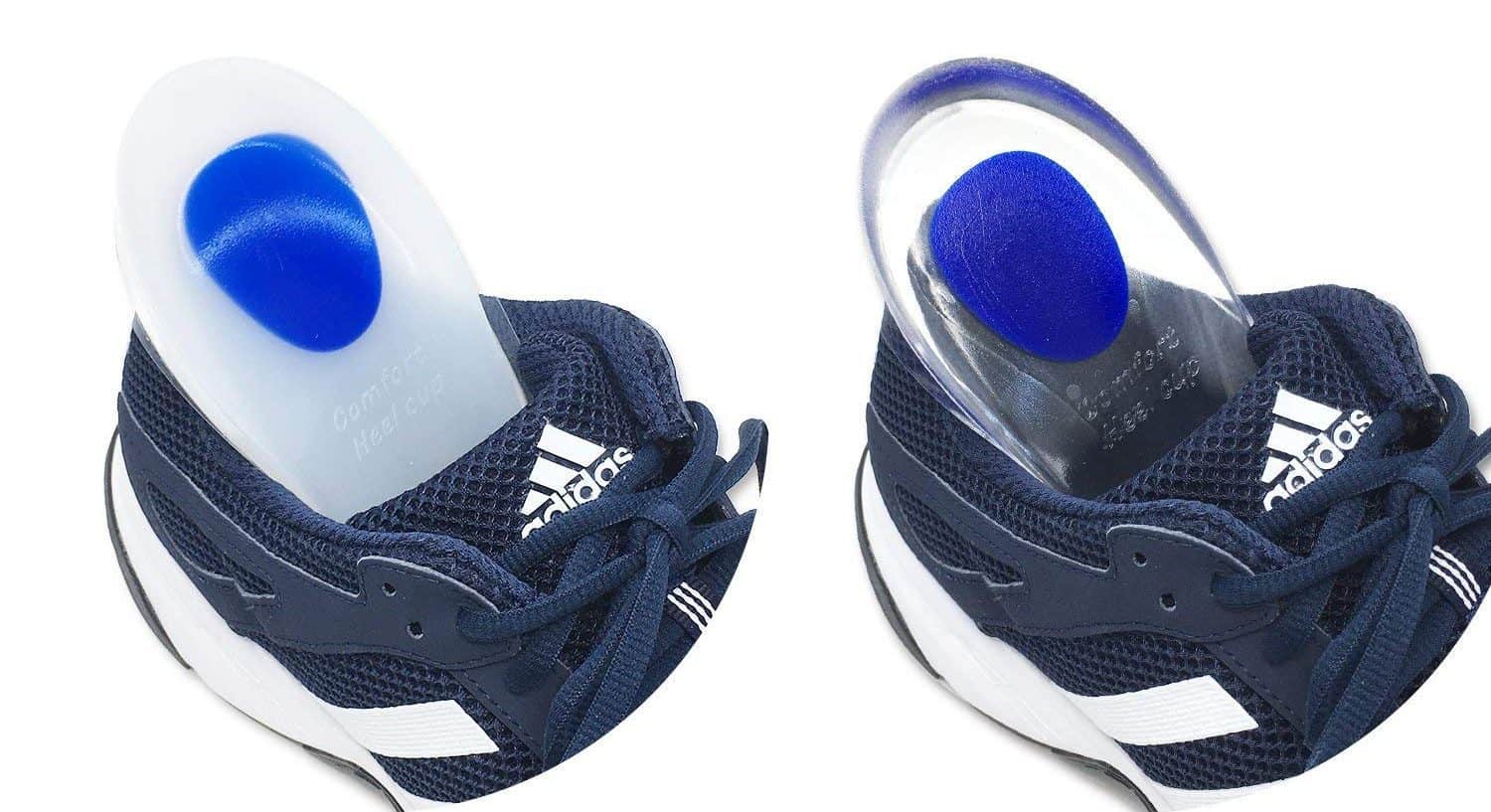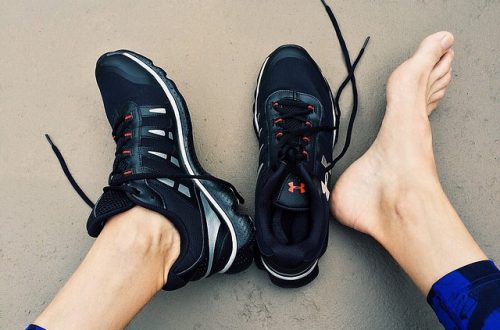Plantar Fasciitis affects 1 in 10 people at some point during their lives. It has been proven that being overweight or obese can increase your risk of developing the condition. [Source]
There are many reasons why a person may be overweight such as diet, inactivity, pregnancy, illness, medication side effects, mobility issues, just to name a few.
Whatever the reason, the added weight is going to impact on your condition and will need to be addressed in some way, if you are to recover and eliminate the pain.
Why does being overweight or obese increase your chances of developing plantar fasciitis? The plantar fascia tissue runs along the base of the foot to create the arch and support your body weight. If you are overweight, the stress burden on the plantar fascia is increased, and so is the risk of damage to the tissue.
We will look further into how your weight affects your plantar fasciitis, and what you can do to help recover from the condition without causing further damage.

The Purpose Of The Foot Arch
The arch of the foot is designed to act as a kind of shock absorber that protects the fragile bones of the foot when you walk, run, exercise etc.
The ‘shock absorber’ is an elastic band of tissue called the plantar fascia, that runs along the base of the foot from the heel bone to the toes, and supports your body weight.
How Does Weight Affect The Foot Arch?
As with any load bearing device, the plantar fascia has a limit to the amount of weight it can carry before it becomes weakened through stress, and therefore more prone to damage.
When a person becomes overweight, obese or even pregnant, the added burden on the plantar fascia can become too much, and tiny micro-tears can develop.
These micro-tears become inflammed and you develop plantar fasciitis.
Left untreated, the damage can become worse over time and develop into a major tear or plantar fascia rupture.
Read our article about major tears and ruptures

The Viscious Cycle of Weight Vs Plantar Fasciitis
When a person is carrying more weight than they should, and they develop some kind of foot pain such as plantar fasciitis, they can enter a viscious cycle of pain vs action.
Let me explain that further….
If you become overweight, you put more stress onto the plantar fascia and it can become damaged and painful.
Losing weight would help ease the condition, however due to the pain being experienced when weight is applied to the foot, exercising is not a desired action.
Here you have the dilemma of wanting to lose weight to ease the pain, however the pain is preventing you from taking action to lose the weight.
As a consequence of no action, sometimes the person will continue to gain more weight further adding to the dilemma, and possibly compounding the damage to the foot.

Methods Of Losing Weight With Plantar Fasciitis
Thankfully, strenuous exercise is only one method of losing weight.
There are many other options that you can try that don’t require putting weight onto your injured foot.
Here are a few of those options:

Anti-Inflammatory Diet
There are many foods that naturally help reduce inflammation within the body. Likewise, there are many foods that will have the opposite effect and will aggravate the inflammation within the body.
Try to adopt a diet that increases your consumption of the more healthy options whilst reducing or eliminating those that are hurting your recovery.
Read our article on How Diet Affects Plantar Fasciitis

Low Impact Exercise
Low impact exercise that doesn’t require you to run, jump, or impact on your feet, is a good way to get your heart rate up, burn calories and help lose weight.
Here are some examples of low impact exercises/sports that you could try
- Cycling
- Swimming
- Yoga*
- Pilates*
- Water Aerobics
- Rowing
* Do not do any moves that would require stretching the foot excessively

Foot Stretches & Strengthening
When you wake each morning, or after a period of rest lasting over an hour, you should gently stretch the plantar fascia prior to standing.
When you rest, the body begins to heal itself, and with plantar fasciitis, this means that those micro-tears begin to close up again.
If you stand up without first ‘gently’ stretching the plantar fascia, you will likely split open those micro-tears once again and be back to sqaure one with your recovery.
Follow our 5 Minute Stretching Routine to help promote healing without adding weight to the plantar fascia.
Our article Eliminate the Constant Pain of Plantar Fasciitis explains in more depth the rest and re-injury cycle.

Use Orthotic Inserts
Using orthotic inserts can help relieve the pain in your foot when weight is applied. There are a variety of inexpensive inserts that are available over the counter from your local pharmacy or online.
For more information about the different kinds of foot orthotics, and which might be right for you, read our article Foot Orthotics Explained

Ice & Heat Therapy
Depending on whether your plantar fasciitis is in the acute or chronic stage, you could try applying either ice or heat therapy to relieve your symptoms.
Acute plantar fasciitis is when the injury or pain is first felt. In these early stages, ice therapy is a good solution.
Once the pain has been around for a while, or has gotten worse over time, you enter the chronic stages of plantar fasciitis. Heat therapy is more beneficial during this stage of the condition.
Our article Ice or Heat Therapy for Plantar Fasciitis will explain in more detail.
Take Action & Become Pain Free!
As you can see form the information provided, there are many ways that you can help your condition without risking further injury to your plantar fasciitis.
It is imperitive that you find a way that works for you to try and reduce your weight and lower the impact on your plantar fascia so that it can make a full and speedy recovery.
By adopting a few changes to the kinds of food you may eat, and introducing a short 5 minute stretching routine, you can dramatically increase your chances of becoming pain free and rid of your plantar fasciitis.






